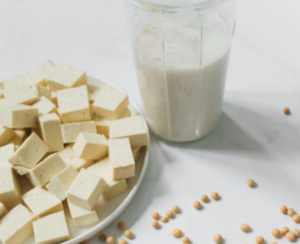Is Soy Healthy?
Soy has copped a bad rep. I very commonly hear people say that they avoid soy because “it’s bad for women” or “it’s estrogenic” or “it gives men man-boobs.” Some of the time, if you ask people why they avoid soy, they can’t really tell you, but they’re entirely adamant it’s the best thing for health. Certainly, there are people who are legitimately allergic to soy, and other subsets of individuals who may benefit from limiting their intake. For others though, soy foods can be a delicious addition to a healthy diet. Let’s tackle the myths.

Is soy estrogenic?
Soy contains isoflavones, a type of phytoestrogen, which work as Selective Estrogen Receptor Modulators, meaning that they have a far weaker estrogenic activity than human estrogen. They have a pro-estrogenic activity at some sites in the body, and an anti-estrogenic activity at others. With soy consumption, we typically see weakly pro-estrogenic activity in the bones, and anti-estrogenic activity in the breast and uterus tissue. Genistein in soy has a 7-30x greater binding affinity for Estrogen-beta receptors, found in bones, over Estrogen-alpha receptors, found in the reproductive tissues.1
Will Soy give men man boobs?
Soy consumption, at normal consumption levels, does not have any feminizing effects on men. Total or free testosterone levels, and semen parameters are not affected by soy consumption.2
A 60 year-old man was found to develop gynecomastia associated with his soy milk consumption. However, it was reported that he was consuming around 3.5 litres of soy milk a day.3 Due to the soy isoflavone’s hugely greater affinity for Estrogen-beta receptors over Estrogen-alpha, it takes a tremendous consumption of soy, far above the norm, to see these kind of results.
Does soy increase breast cancer risk?
Evidence based on large case-control trials suggest that soy intake at the level seen in Asian populations may be protective against breast cancer.4
In those who have breast cancer, soy may also be protective. In a pooled analysis of both Chinese and American women, isoflavone intake of over 10mg was associated with a 17% reduced risk of dying from breast cancer, and 25% lower risk of breast cancer reoccurring.5
Soy may be particularly protective in post-menopausal populations 6, and when consumed in childhood and adolescence.7,8 In post-menopausal women, high soy intake reduced recurrence of ER- cancers by 36% and ER+ cancers by 35%.9
Soy is also especially protective in BRCA mutation patients; with the highest quartile of soy intake associated with a 61% reduced risk of breast cancer in BRCA1 and BRCA2 carriers, and highest meat intake associated with almost a doubly higher risk.10
Soy consumption may even be more protective in vegetarians, since the isoflavone daidzein can be metabolised by those with equol-producing bacteria in their intestines into a compound called S-equol. One study showed vegetarians were 4.25 times more like to be equol-producers than non-vegetarians.11

The best things about soy
So now we’ve cleared up some of the misconceptions surrounding soy products, let’s look at more reasons why we might want to include them in our diet:
The amino acid composition: When we talk about quality of protein we refer to the composition of amino acids in that protein, and the digestibility of that protein. Soy protein isolate has a digestibility of 95% (rivalling the majority of animal proteins), whilst tofu has a digestibility at 93%. The Protein Digestibility Corrected Amino Acid Score (PDCAAS) is based upon both its digestibility and its proximity to an amino acid content required by humans for good health. Soy protein isolate is given a PDCAAS of 1.00 (the maximum score), since its amino acid composition is excellent, and due to the removal of fibre, its digestibility is extremely high. Tofu and beef are both given PDCAAS of 0.9 or higher, demonstrating that soy foods make any claims of inferior protein on a plant based diet, obsolete.12
May lower risk of breast and prostate cancer
We’ve already discussed the potential reduction in risk of breast cancer seen with soy consumption. It is also proposed that soy consumption may be associated with a decrease in prostate cancer incidence too.13
Lowers cholesterol.
Soy protein consumption has been shown to lower both Total and LDL cholesterol, particularly in those with elevated cholesterol.14 Soy consumption may be associated with prevention of coronary artery disease. 15
Extremely nutrient dense
Aside from amino acids and antioxidants, soy foods are extremely dense in minerals including iron, zinc and choline. Soy foods are a great source of choline on a plant based diet, which is critical for acetylcholine production, a neurotransmitter required for memory, attention span, REM sleep and the function of the parasympathetic nervous system.
Estrogen in dairy versus phytoestrogens in soy
Unlike soy’s selective estrogen receptor modulating properties, dairy milk has been shown to be the highest source of dietary estrogen in the American diet, supplying 60-80% of ingested female sex steroids.16
One trial explored the hormonal implications of consuming cow’s milk and noted “After the intake of cow milk, serum estrone (E1) and progesterone concentrations significantly increased, and serum luteinizing hormone, follicle-stimulating hormone and testosterone significantly decreased in men. Urine concentrations of E1, estradiol, estriol and pregnanediol significantly increased in all adults and children.”17
Consumption of dairy products may be associated with prostate cancer growth. In 14 separate petri dish experiments, exposure to milk increased the growth of LNCaP prostate cancer cells by over 30%. 18,19
Things to be noted
Choosing the right kind of soy.
It is very important when choosing soy products that we consume healthful, minimally processed, organic and non-GMO products, wherever possible. This can include: edamame, soy beans, tofu or tempeh. Packaged, processed goods containing soy are unlikely to be health-promoting, and soy protein isolate should be avoided for reasons discussed later.
Those with thyroid issues may need to be wary.
Soy consumption may exacerbate thyroid dysfunction when consumed by those with insufficient iodine consumption, and may be best avoided on minimised by those with existing or subclinical thyroid disorder. 20
Soy protein isolate and IGF-1
Animal protein consumption is associated with an increase IGF-1, implicated in the growth of cancers.21 However, because of its high levels of certain amino acids, excess soy consumption is also associated with increased IGF-1, and existing studies indicate that 3-5 servings a day is the safe upper range for consumption.22 Soy protein isolate, where the fibre and other beneficial nutrients are removed may more readily raise IGF-1 levels than less processed soy products.23
So, that’s it; I like to enjoy about two servings of organic, non-GMO tofu or tempeh a day because of its amazing nutritional profile and health protective properties. It took me a while to discover how to prepare my soy foods in a way that I truly enjoyed, and now I positively crave. I’ve put together some recipes to get you started on incorporating more healthy soy foods into your diet. Enjoy!
References
- McCarty MF. Isoflavones made simple – Genistein’s agonist activity for the beta-type estrogen receptor mediates their health benefits. Med Hypotheses. 2006;66(6):1093-1114. doi:10.1016/j.mehy.2004.11.046
- Messina M. Soybean isoflavone exposure does not have feminizing effects on men: a critical examination of the clinical evidence. Fertil Steril. 2010;93(7):2095-2104. doi:10.1016/j.fertnstert.2010.03.002
- Martinez J, Lewi J. An Unusual Case of Gynecomastia Associated with Soy Product Consumption. Endocr Pract. 2008;14(4):415-418. doi:10.4158/EP.14.4.415
- Wu AH, Yu MC, Tseng C-C, Pike MC. Epidemiology of soy exposures and breast cancer risk. Br J Cancer. 2008;98(1):9-14. doi:10.1038/sj.bjc.6604145
- Nechuta SJ, Caan BJ, Chen WY, et al. Soy food intake after diagnosis of breast cancer and survival: an in-depth analysis of combined evidence from cohort studies of US and Chinese women. Am J Clin Nutr. 2012;96(1):123-132. doi:10.3945/ajcn.112.035972
- Fink BN, Steck SE, Wolff MS, et al. Dietary Flavonoid Intake and Breast Cancer Survival among Women on Long Island. Cancer Epidemiol Biomarkers Prev. 2007;16(11):2285-2292. doi:10.1158/1055-9965.EPI-07-0245
- Korde LA, Wu AH, Fears T, et al. Childhood Soy Intake and Breast Cancer Risk in Asian American Women. 2009. doi:10.1158/1055-9965.EPI-08-0405
- Ou XS, Jin F, Dai Q, et al. Soyfood Intake during Adolescence and Subsequent Risk of Breast Cancer among Chinese Women 1.; 2001. http://cebp.aacrjournals.org/content/cebp/10/5/483.full.pdf. Accessed March 1, 2019.
- Asian Pacific Organization for Cancer Prevention., International Association of Cancer Registries. Post-Diagnosis Soy Food Intake and Breast Cancer Survival: A Meta-Analysis of Cohort Studies. Vol 14. Asian Pacific Organization for Cancer Prevention; 2000. http://journal.waocp.org/article_27665.html. Accessed March 1, 2019.
- Ko K-P, Kim S-W, Ma SH, et al. Dietary intake and breast cancer among carriers and noncarriers of BRCA mutations in the Korean Hereditary Breast Cancer Study. Am J Clin Nutr. 2013;98(6):1493-1501. doi:10.3945/ajcn.112.057760
- Setchell KDR, Cole SJ. Method of Defining Equol-Producer Status and Its Frequency among Vegetarians. J Nutr. 2006;136(8):2188-2193. doi:10.1093/jn/136.8.2188
- Davis B, Melina RD VM. Becoming Vegan: The Complete Reference to Plant-Based Nutrition (Comprehensive Edition). Summertown, Tennessee, USA: Book Publishing Company; 2014.
- van Die MD, Bone KM, Williams SG, Pirotta M V. Soy and soy isoflavones in prostate cancer: a systematic review and meta-analysis of randomized controlled trials. BJU Int. 2014;113(5b):E119-E130. doi:10.1111/bju.12435
- Taku K, Umegaki K, Sato Y, Taki Y, Endoh K, Watanabe S. Soy isoflavones lower serum total and LDL cholesterol in humans: a meta-analysis of 11 randomized controlled trials. Am J Clin Nutr. 2007;85(4):1148-1156. doi:10.1093/ajcn/85.4.1148
- Cassidy A, de Pascual Teresa S, Rimbach G. Molecular mechanisms by which dietary isoflavones potentially prevent atherosclerosis. Expert Rev Mol Med. 2003;5(24):1-15. doi:10.1017/S1462399403006732
- Hartmann, Lacorn &, Steinhart. Natural occurrence of steroid hormones in food. Food Chem. 1998;62(1):7-20. doi:10.1016/S0308-8146(97)00150-7
- Maruyama K, Oshima T, Ohyama K. Exposure to exogenous estrogen through intake of commercial milk produced from pregnant cows. Pediatr Int. 2010;52(1):33-38. doi:10.1111/j.1442-200X.2009.02890.x
- Tate PL, Bibb R, Larcom LL. Milk Stimulates Growth of Prostate Cancer Cells in Culture. Nutr Cancer. 2011;63(8):1361-1366. doi:10.1080/01635581.2011.609306
- Qin L-Q, Xu J-Y, Wang P-Y, Tong J, Hoshi K. Milk consumption is a risk factor for prostate cancer in Western countries: evidence from cohort studies. Asia Pac J Clin Nutr. 2007;16(3):467-476. http://www.ncbi.nlm.nih.gov/pubmed/17704029. Accessed March 1, 2019.
- Marini H, Polito F, Adamo EB, Bitto A, Squadrito F, Benvenga S. Update on genistein and thyroid: an overall message of safety. Front Endocrinol (Lausanne). 2012;3:94. doi:10.3389/fendo.2012.00094
- Salvioli S, Capri M, Bucci L, et al. Why do centenarians escape or postpone cancer? The role of IGF-1, inflammation and p53. Cancer Immunol Immunother. 2009;58(12):1909-1917. doi:10.1007/s00262-008-0639-6
- Nagata C, Shimizu H, Takami R, Hayashi M, Takeda N, Yasuda K. Dietary Soy and Fats in Relation to Serum Insulin-Like Growth Factor-1 and Insulin-Like Growth Factor-Binding Protein-3 Levels in Premenopausal Japanese Women. Nutr Cancer. 2003;45(2):185-189. doi:10.1207/S15327914NC4502_07
- Messina M, Magee P. Does soy protein affect circulating levels of unbound IGF-1? Eur J Nutr. 2018;57(2):423-432. doi:10.1007/s00394-017-1459-2





Leave a Reply